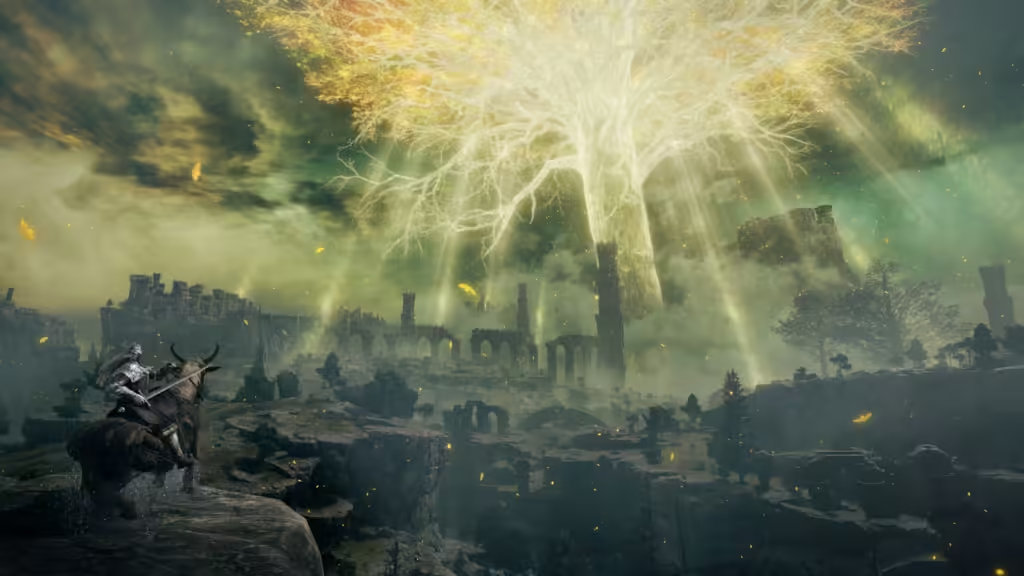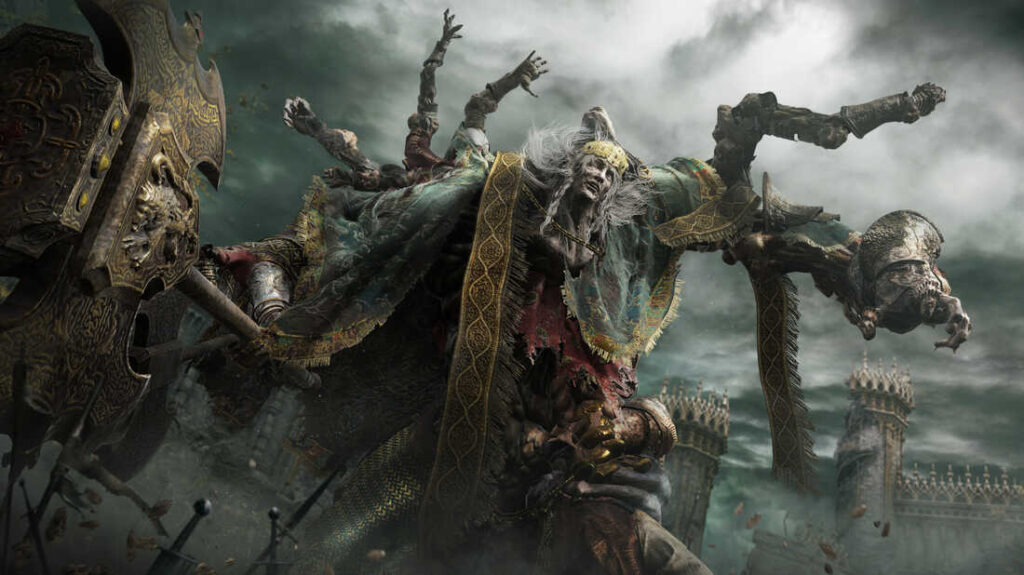When Elden Ring was first announced, the gaming world buzzed with excitement. A collaboration between the revered game developer FromSoftware and the legendary author George R. R. Martin, Elden Ring promised a rich tapestry of lore, challenging gameplay, and a sprawling open world—a significant evolution from the tightly controlled environments of previous FromSoftware titles. Upon its release, Elden Ring exceeded expectations, delivering a game that is as much a work of art as it is a test of skill and endurance. This review delves into the game’s many facets, exploring its world-building, gameplay mechanics, narrative, and the thematic resonance that underpins the entire experience.

The Lands Between: A World of Ruin and Wonder
Elden Ring unfolds in the Lands Between, an expansive world characterized by its breathtaking beauty and haunting decay. From the moment players step into Limgrave, the game’s starting area, they are met with a vast, open world that beckons exploration. This world is not just large; it is meticulously crafted, filled with ruins that tell the story of a once-great civilization now fallen into ruin.
Environmental Storytelling: The Echoes of a Lost Age
The Lands Between is a masterclass in environmental storytelling. Every location, from the dilapidated churches to the towering castles, is laden with history. The architecture reflects the glory and subsequent decay of a world that has suffered from the Shattering, a cataclysmic event that fragmented the Elden Ring and plunged the world into chaos.
As you explore, you’ll find remnants of ancient conflicts—abandoned fortresses, battlefields littered with the bones of long-dead warriors, and statues commemorating forgotten heroes. These elements are not just set dressing; they are integral to the game’s narrative, offering clues about the world’s history and the events that led to its current state.
The visual design of these environments is nothing short of stunning. The world is divided into distinct regions, each with its own unique aesthetic. Limgrave’s lush, rolling hills give way to the eerie, crimson skies of Caelid, a land ravaged by disease and rot. The contrast between these regions reinforces the sense of a world torn apart, both physically and spiritually.

Biomes and Exploration: A World of Infinite Variety
The diversity of the game’s biomes is one of its greatest strengths. Each region feels like a world unto itself, with its own climate, culture, and challenges. The Atlus Plateau, with its golden fields and grand fortresses, contrasts sharply with the desolate, volcanic landscape of Mt. Gelmir. Meanwhile, the icy wastelands of the Mountaintops of the Giants offer a stark, unforgiving environment where survival is as much a battle against the elements as it is against enemies.
Exploration in Elden Ring is incredibly rewarding. The game’s open-world design allows players to venture off the beaten path and discover hidden areas, secret bosses, and powerful weapons. The lack of hand-holding—no quest markers or detailed maps—means that players must rely on their instincts and curiosity to uncover the game’s many secrets. This sense of discovery is one of Elden Ring’s most satisfying aspects, encouraging players to explore every corner of the map.

The Heart of Battle: Combat and Player Agency
Combat in Elden Ring is an evolution of the systems FromSoftware has perfected over the years. It retains the deliberate, methodical pace of the Dark Souls series, where every move must be calculated, but it also incorporates elements from Bloodborne and Sekiro to create a more fluid, dynamic experience.
Weapons, Magic, and Strategy: The Arsenal at Your Disposal
Elden Ring offers an unparalleled level of customization in its combat system. The game features an extensive array of weapons, ranging from nimble katanas to massive great hammers, each with its own unique move set and special abilities. This variety allows players to experiment with different playstyles, whether they prefer the raw power of heavy weapons or the precision and speed of lighter arms.
Magic in Elden Ring is equally diverse. Sorceries and incantations offer powerful options for players who prefer a more ranged or supportive role in combat. The game’s magic system is more accessible than in previous titles, with spells that range from devastating offensive attacks to healing and buffing abilities. The inclusion of Spirit Summons—ethereal companions that can be called upon in battle—adds another layer of strategy, allowing players to tailor their approach to different encounters.
The introduction of Ashes of War, which are special abilities that can be applied to weapons, further enhances combat depth. These abilities allow players to modify their weapons to suit their preferred playstyle, whether that means adding elemental damage, increasing critical hit potential, or enabling unique attacks that can turn the tide of battle. The flexibility of this system encourages experimentation and allows for a high degree of player agency.

Boss Battles: The Pinnacle of Challenge
Boss battles have always been a hallmark of FromSoftware’s games, and Elden Ring continues this tradition with some of the most challenging and memorable encounters in gaming. Each boss in Elden Ring is a unique puzzle, requiring players to learn attack patterns, manage their resources, and stay calm under pressure.
The game’s major bosses—figures like Godrick the Grafted, Radahn the Conqueror of the Stars, and Malenia, Blade of Miquella—are multi-phase encounters that test every aspect of the player’s skill. These battles are designed to be challenging but fair, with clear tells for each attack and ample opportunities for counterplay. The satisfaction of defeating these formidable foes is immense, often requiring several attempts and a deep understanding of the game’s mechanics.
In addition to the main story bosses, Elden Ring features a plethora of optional bosses hidden throughout the world. These encounters range from reimagined versions of classic FromSoftware enemies to entirely new creations that challenge players in unexpected ways. Finding and defeating these optional bosses often yields powerful rewards, making exploration and experimentation worthwhile.

Narrative and Lore: A World of Myth and Mystery
Elden Ring’s narrative is both epic in scope and deeply personal, weaving a tale of gods, demigods, and the fall of a once-great civilization. The story, co-written by George R. R. Martin, is delivered through a combination of cryptic NPC dialogue, item descriptions, and environmental storytelling. This approach to narrative, which encourages players to piece together the lore on their own, has become a hallmark of FromSoftware’s design philosophy.
The Story of the Tarnished: A Journey of Redemption and Power
Players take on the role of the Tarnished, a character exiled from the Lands Between and now called back to restore the Elden Ring and become the Elden Lord. The journey of the Tarnished is one of redemption, power, and self-discovery. Unlike the more straightforward narratives of many RPGs, Elden Ring offers a story that is rich in ambiguity, with multiple interpretations possible depending on how much the player uncovers.
The game’s world is populated by a cast of tragic, complex characters, each with their own motivations and backstories. These characters, such as the mysterious Melina, the treacherous Sorcerer Rogier, and the loyal Ranni the Witch, play pivotal roles in the player’s journey, offering assistance, quests, or challenges that shape the narrative. The fates of these characters are often intertwined with the choices the player makes, leading to multiple possible endings.
The game’s narrative structure, which leaves much to the player’s imagination and interpretation, creates a sense of mystery and intrigue. This approach not only encourages replayability but also fosters a vibrant community of players who share theories, discoveries, and interpretations of the game’s lore.

Themes and Symbolism: The Heart of Elden Ring
At its core, Elden Ring explores themes of power, ambition, and the consequences of hubris. The Shattering of the Elden Ring—a cataclysmic event that fractured the world and set the stage for the player’s journey—is a direct result of the gods’ lust for power. Each major boss represents a different aspect of this theme, embodying the dangers of unchecked ambition and the corrupting influence of power.
For instance, Godrick the Grafted’s obsession with strength leads him to graft the limbs of his enemies onto his own body, creating a grotesque, multi-limbed monstrosity. His fall from grace serves as a cautionary tale about the perils of seeking power at any cost. Similarly, Malenia’s struggle with the Scarlet Rot—a disease that consumes her body and soul—symbolizes the destructive consequences of ambition and the inevitability of decay.
The game also delves into themes of fate and free will, questioning whether the Tarnished is merely a pawn in a greater cosmic game or a true agent of change. The multiple endings, each reflecting different philosophical stances on these themes, allow players to shape the outcome of the story in a way that resonates with their personal interpretation of the narrative.

Aesthetic and Sound: The Atmosphere of Elden Ring
The visual and auditory design of Elden Ring is integral to its ability to immerse players in its world. The game’s aesthetic is a blend of high fantasy and dark, gothic elements, creating an atmosphere that is both awe-inspiring and unsettling.
Visual Design: A World of Beauty and Dread
The art direction in Elden Ring is nothing short of breathtaking. The game’s environments are richly detailed, with each region possessing its own distinct visual identity. From the golden, sunlit plains of Limgrave to the eerie, otherworldly beauty of the Eternal City of Nokron, every location in the game is a feast for the eyes.
Character and enemy designs are equally impressive, ranging from the grotesque to the sublime. The game’s bosses, in particular, are masterworks of design, with each one reflecting their narrative significance through their appearance and animations. The attention to detail in these designs adds a layer of depth to the game’s storytelling, making each encounter feel unique and memorable.

Sound and Music: The Soul of the Game
The sound design in Elden Ring is a crucial component of its atmosphere. The game’s score, composed by FromSoftware’s Yuka Kitamura and her team, is a powerful, sweeping orchestral work that underscores the epic scale of the player’s journey. Each region and major boss is accompanied by its own unique musical theme, enhancing the emotional impact of the game’s most intense moments.
Ambient sound also plays a significant role in Elden Ring, with the subtle noises of wind, water, and distant creatures creating a sense of place and immersion. The sound design enhances the tension of exploration, making players keenly aware of their surroundings as they traverse the dangerous world of the Lands Between.

A Monumental Achievement
Elden Ring is a monumental achievement in game design, world-building, and storytelling. It is a game that challenges players not only in terms of skill but also in terms of thought, rewarding those who delve deep into its world with a rich, multifaceted experience. The Lands Between is a place of beauty and terror, filled with secrets waiting to be uncovered and challenges waiting to be conquered.
For those willing to embrace its difficulty and immerse themselves in its lore, Elden Ring offers an unparalleled journey—one that will be remembered as a defining moment in gaming history. It is a game that exemplifies the power of interactive storytelling, where every player’s experience is shaped by their choices, their actions, and their understanding of the world around them.
In Elden Ring, FromSoftware has forged a world that is as captivating as it is unforgiving, a world that will continue to inspire, challenge, and enthrall players for years to come.









